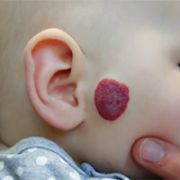Vascular tumor | Hemangioma

There are different variants of diseases related to vascular tumors. In principle, vascular tumors consist of solid masses with a dominant vascular component associated with true endothelial proliferation. In general, according to their biological behavior they are divided into benign , locally aggressive and malignant vascular tumors.
Infantile hemangioma, or "blood sponge," is by far the most common vascular tumor, a benign tumor with raspberry color mostly of the skin likely caused by stray stem cells which develops in about three percent of all newborns. Premature babies are affected even more frequently.
The majority of infantile hemangiomas are harmless initially proliferating red capillary tumors affecting the skin surface or skin and subcutaneous tissue, which tend to involute spontaneously. The majority of infantile hemangiomas do not need to be treated. If the hemangioma is located at a unfavorable site causing functional impairment or disfigurement (for example, eyelid, eye socket, face, ano-genital, hand, or foot), therapy should initiated be as early as possible. This also applies to extensive (segmental) hemangiomas and involvement of internal organs or the respiratory tract. The discovery of the effectiveness of the beta-blocker propranolol has dramatically changed the treatment of infantile hemangioma, making laser therapy and surgical resections less common. Congenital hemangiomas are far less common benign vascular tumors, are already fully developed at birth, may spontaneously completely (RICH; Rapidly Involuting Congenital Hemangioma) or partially regress (PICH; Partially Involuting Congenital Hemangioma) or may not regress (NICH; Non-Involuting Congenital Hemangioma) at all and are much more difficult to treat.
The most important representative of locally aggressive vascular tumors is kaposiform hemangioendothelioma (KHE), which can cause dangerous blood coagulation disorders (Kasabach-Merritt phenomenon).
Malignant vascular tumors such as angiosarcoma are much rarer and require all areas of oncological therapy.
